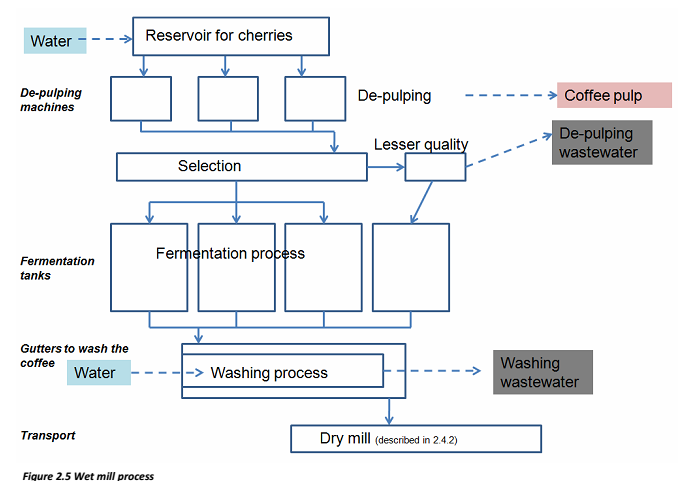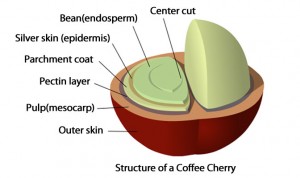| INTRODUCTION |
 |
There are two different methods which can be used to process the coffee cherries: the dry mill and the wet mill. The water use at the wet mills is diverse in both quantity and purpose.
30% of the water is utilized for the de‐pulping process and 70% for the washing of the fermented grains. From this 70%, 20% is used for eliminating the decomposed mucilage and the remaining 50% is very clean wastewater that is used to finish cleaning and selecting the grains.
|
|
|
| CHARACTERIZATION OF COFFEE WASTEWATER AND RO TREATMENT PLANT |
| Coffee wastewater contains large concentrations of sugars, cellulose, caffeine and pectic substances. |
 |
| Water de-pulping |
Water from washing |
| Proteines |
8.9% |
Pectic substances |
23.4% |
| Tannins |
10.0% |
Sugars |
54.2% |
| Chlorogenic acid |
14.5% |
Cellulose |
20.4% |
| Caffeine |
22.0% |
|
|
| Sugars |
45.3% |
|
|
|
|
| |
| Table 1. Characterization of coffee wastewater |
| Parameter |
Total average (mg/L) |
De‐pulping water (mg/L) |
Water from washing (mg/L) |
| Total suspended solids |
7 000 – 10 900 |
13 200 |
2 900 |
| pH |
4-5 |
4-5 |
4-5 |
| BOD5 |
10000-13000 |
1000-9000 |
1000-4000 |
| COD |
18000-23000 |
2000-14000 |
850-10000 |
|
|
The effluent from the unit was being treated in the Effluent Treatment Plant (ETP) and the discharge was being gardening towards water conservation, As corporate policy there was a requirement to reduce effluent loads through wastewater recovery for recycle/reuse.
|
| Parameters |
Unit |
Effluent (Input to RO) |
Permeate (RO Output) |
| Flow (recovery rate 66%) |
cum/day |
500 |
330 |
| pH |
- |
6.8-7.2 |
6.5 |
| Total Dissolved Solids |
ppm |
800-1000 |
100 |
| Chemical Oxygen Demand |
ppm |
220 |
10 |
| Biochemical Oxygen Demand |
ppm |
80 |
- |
| Silica |
ppm |
10 |
<1 |
| Total Suspended Solids |
ppm |
100 |
0 |
| Chlorides |
ppm |
70 |
<10 |
| Sulphates |
ppm |
<50 |
<10 |
|


